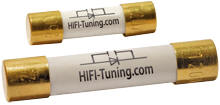|
You are reading the older HTML site
Positive Feedback ISSUE 51
A Finely Tuned Analog Accessory Trio
HiFi-Tuning US-Gold² Fuses
Bernd Ahne of HiFi-Tuning is rapidly making a name for himself in the high-end audio accessory sector with the release of products such as the VRO3 record weight, a CD disc demagnetizer, Schuko AC plugs, an AC Line Noise Destroyer and specially designed, audiophile fuses. Now HiFi-Tuning's fuses have piqued my curiosity for quite some time; it wasn't until the beginning of this year and following my meeting Bernd in person at The Show in Vegas, that HiFi-Tuning began making a replacement for my conrad-johnson amplifier's KTK-1 or -2 fuses (a fast acting, 10.3 x 38 mm fuse with a molded melamine [plastic] body and nickel plated, bronze end caps). What's so special about these HiFi-Tuning fuses? To being with, each fuse is specifically engineered so as to add negligible extra resistance to the circuit and separate in the event of excessive current. Next, in contrast to conventional fuses that use glass bodies and some sort of tin/lead alloy element wire, the HiFi-Tuning US-Gold2 fuses reviewed here are made with a ceramic body, silver/gold/copper plated caps, brass end caps (copper and bronze) and a silver wire fuse element. Finally, each fuse is cryogenically treated using a specially controlled process to -315oF (for reference absolute zero is about -460oF), to give better orientation (order) of the crystalline and molecular structure. (See www.cryogenicsinternational.com for more information.) Now I can already see the naysayer's eyes rolling up in the back of their sockets. Fuses? Harrumph! Hogwash! Humbug! More high-end audio snake oil! Well as it turns out, there's more to the HiFi-Tuning fuse story than meets the eye. HiFi-Tuning has carried out some measurements on their fuses in order to identify those factors responsible for the "sound" of fuses. The first and most obvious electrical difference between the HiFi-Tuning audiophile grade fuses and most stock fuses is their DC resistance values; HiFi Tuning fuse's DC resistance measures up to 8X less than the equivalent stock fuse. (DC-resistance values were determined by GECOM Technologies GmbH test labs; www.gecom-technologies.com and were measured with equipment including a Burster 2302 Microohm Meter with Kelvin leads and an Agilent 3458a 8 ½ digit multimeter.) Bernd is quick to point out, however, "DC-resistance is important, but even more important is the voltage drop across a fuse or wire (Voltage drop is calculated using the formula U (voltage) = I (current) x R (resistance). All fuses cause a voltage drop in the circuit on DC as well as AC-voltages. The worse the fuse quality, the higher the voltage drop and as a result, current (pulse) limiting. But there's even more to the HiFi-Tuning fuses story than simply their lower DC resistance. According to Bernd, there's a litany of reasons why HiFi-Tuning fuses improve a component's sound including: 1) a reduction in microphonics (glass body fuses are more sensitive to the effects of vibrations than those with ceramic body); 2) the quality of the contact between fuse wire and caps; 3) Stability of fuse contact to fuse holder (bad surface, or less conductive, even oxidised caps will sound worse); 4) Material mix of caps (magnetic eg. Nickel plated materials sound worse than copper, gold plated, which in turn doesn't sound as good as silver; and 5) Material and make of fuse element (spiral wire, in part since its longer length due to helical nature, sounds the worst and pure silver, straight wire the best). In addition, HiFi-Tuning fuses are directional (this is also measureable). Now the effect of switching the direction of the fuses using Roy Haynes' Out of the Afternoon (Analogue Productions/Impulse AS-23, 45 rpm) is subtle but nonetheless incorrectly oriented, the HiFi-Tuning fuses produce a sound that is a little pinched, boring, rolled off and more veiled. Now directly comparing the stock with the HiFi-Tuning fuses is a little more complicated than simply switching between stock and HiFi-Tuning fuses. Both conrad-johnson amplifiers—the LP140 M or the ART—take 30 to 60 minutes to warm-up after being shut down—even if they've been powered on and playing for several hours. So all technicalities aside, do the HiFi-Tuning fuses make a difference? Absolutely! Furthermore, the higher the system's resolution capabilities, the greater the benefit! Take "Black Coffee" from the 15-ips/2-track Jacqui Naylor tape the number one (Tape Project TP-001). With the HiFi-Tuning fuses, Jon Evans' bass line is cleaner and better articulated. Jacqui's voice has a greater sense of three-dimensionality, not unlike that heard with highly desirable SET amplifiers. Then one can toss in a greater sense of dynamic contrasts. More interestingly and it's another interesting case of what distortions the ear can "listen" through, there's clearly less grain in upper midrange. Now that's not to imply that the ART (or LP140 M) sound grainy. It's just that the HiFi-Tuning fuses remove another layer of grain. In the end, Jacqui's voice sounds less mechanical and is much easier to listen to. On the sensational 45 rpm Roy Haynes reissue Out of the Afternoon, the stock fuses impart a slight flatter, sandier and muted sound to Kirk's horn than do the HiFi-Tuning fuses. Nor does one pick up pick up quite as much of the reverb as with HiFi-Tuning fuses. Compared to the HiFi-Tuning fuses, the stock fuses loses some upper and lower octave transparency on Haynes' drums and cymbals. In addition, Haynes' drums are slightly fatter sounding with the stock than with the HiFi-Tuning fuses. There was only one potential drawback that I think of with the HiFi-Tuning fuses. Conrad-johnson uses the KTK fuses to protect the amplifier against output tube failure. So when that 6550 tube eventually goes, and like death and taxes, that's a certainty, the tube will take out the fuse. So conrad-johnson owners will have to potentially replace one or two HiFi-Tuning fuses fuse every two or so years. In addition, conrad-johnson amplifier owners should keep around a stock of the conventional fuses to check which tube is bad before replacing the HiFi-Tuning fuses! Looking back on the various audio accessories that have passed through the system over the years, the HiFi-Tuning fuses really deliver the goods and for a modest price at that!
Distributed by
darklab NAB Quick Release Studio Hub Adapters
Now the second member of the analog trio might not directly improve the sound of a reel-to-reel deck but the darklab's NAB Studio Hub Adaptor make switching reels a breeze, prevent scratching of the deck while removing the reels, not to mention allowing for better tape packing that can extend the tape's lifetime. The anodized darklab Aluminum adapters come in six colors including black, blue, chrome, clear aluminum, gold and red. Darklab purchasers can also select from two other hub options including either a brushed Al center or leading edge of the hub. Tapeheads can further soup up the look of their decks with the addition of matching black, blue or red reels.
Technics reel-to-reel deck owners are intimately
familiar with the tape playing process. The stock hub is aligned with the slots
in the 10-inch reel and then the reel plus stock hub is slipped over the reel
clamper; the reel clamper is then pulled out and turned to lock down either the
feed and/or take-up reels. By contrast, the darklab hubs are semi-permanently
fastened to the reel clamper; the take-up and/or feed reels are then aligned with the slots
on the darklab hub, slipped into place and then the darklab hub is either turned
clockwise to lock down the reel or counterclockwise to remove the reel. So in a
nutshell, no fuss, no muss with the darklab hubs!
Brattig's goal all along, however, was not to make
the cheapest but the best product. So Brattig opted to improve upon a few
aspects of the original hub adapter's design, in particular eliminating the
screws holding the aluminum tops to the bottom piece. This design change is made
possible by the extremely tight machining tolerances of today's modern CAD/CNC
machining. (In fact, Brattig was awarded a German patent for this design). In
the end, this upgrade according to Brattig, "markedly reduces winding
vibrations, and improves tape packing, even on fast winding." A great addition for any reel-to-reel tape deck!
Distributed by:
HVM Reel-to-Reel Tape Deck Cover
One never knows what audiophile treasures lie hidden in the pages of eBay. Take for instance, reel-to-reel tape decks. Several weeks ago, I was doing my usual "Technics reel" eBay search and what appears in the list? A new Technics RS-1700 reel-to-reel soft dust cover. As tapeheads know, finding soft or hard covers (that don't work with the darklab hubs) for their reel-to-reel decks are next to impossible and when available, go for big bucks. And dust and dirt is the bane of reel-to-reel tape decks! A few emails and one conversation later, it turns out that Heather initially began this venture making the last member of this trio of accessories for her husband's audio equipment beginning with his Pioneer reel-to-reel tape deck. And thanks to eBay, Heather was able to turn her sewing acumen into a new business endeavor for audiophiles like her husband. Each HVM tape deck cover is custom-made from long lasting, black duck canvas cloth and is available not only for Technics machines, but also Revox, Pioneer, TEAC or Akai decks (check out the short 18 second video on the website where Heather describes her dust covers). Before making each cover, Heather requires the following information: Reel-to-reel tape machine dimensions (depth, width and height); Do you want the cover to fit over the reels? Do you use 7 or 10 inch reels? Do you use Revox style hubs? Then Heather personalizes each cover by gold embroidering the make and model number of each tape deck. It takes Heather roughly 2 to 3 days to complete each HVM reel-to-reel tape deck; covers usually ship within 7 to 10 days after payment. These HVM covers are far sturdier (and won't show claw marks) than the original soft plastic Technics covers, especially if one has kitties that like to sleep on top of your reel-to-reel deck. An additional bonus is that Heather can also make dust covers for almost any other piece of audio gear including the most popular one, speakers. Heather's reel-to-reel tape deck covers are quite possibly the audio steal of the year! There's no doubt she could easily charge two to three times the price for these covers and no one would blink.
web address:
http://hvmreelcovers.yolasite.com
|


